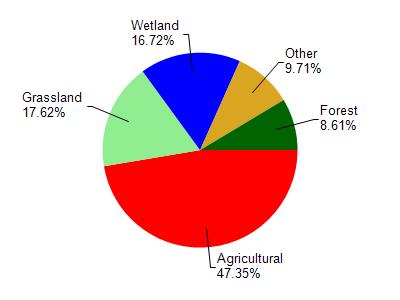Sheboygan
No
No
No
Fish and Aquatic Life
Overview
UNNAMED TRIBUTARY TO SHEBOYGAN MARSH (ELKHART LAKE CREEK), SHEBOYGAN COUNTY
T16N R21E Sec. 30 Stream Length = 0.8 miles
Elkhart Lake Creek (local name) originates as an outlet from the northeast end of Elkhart Lake, adjacent to the public boat launch near County Highway “P”. This low gradient stream, meanders approximately 0.8 miles through a large wetland complex that is part of the Sheboygan Marsh and discharges to the South Ditch of the marsh. The surrounding watershed is primarily wetland and provides an excellent buffer for the stream.
WDNR personnel surveyed approximately 200 meters of the stream’s fish community and habitat in August 2000. Only 33 individuals were captured during the fish shocking survey; too few to calculate an index of biotic integrity. Fish species that were present included bluegill, pumpkinseed, johnny darter, central mudminnow, black bullhead, common carp, largemouth bass, and northern pike. Fish communities may be limited due to low dissolved oxygen (DO) levels at certain periods and lack of fish cover. Fish use the outlet area of Elkhart Lake as a refuge when DO levels are low in the Sheboygan Marsh. This typically occurs during the hot summer months.
Stream habitat was limited due to the lack of fish cover and habitat types. The bottom substrate consists primarily of sand and silt, and the number of riffles and pools are very few. Zebra mussels are abundant in this stream near the outlet of Elkhart Lake with the population diminsihing downstream towards the South Ditch. Zebra mussles extend the length of the stream and zebra mussels have been found in the Sheboygan Marsh South Ditch in low concentrations (pers. Comm. Galarneau).
Date 2001
Author Aquatic Biologist
Condition
Wisconsin has over 84,000 miles of streams, 15,000 lakes and milllions of acres of wetlands. Assessing the condition of this vast amount of water is challenging. The state's water monitoring program uses a media-based, cross-program approach to analyze water condition. An updated monitoring strategy (2015-2020) is now available. Compliance with Clean Water Act fishable, swimmable standards are located in the Executive Summary of Water Condition in 2018. See also the 'monitoring and projects' tab.
Management Goals
Wisconsin's Water Quality Standards provide qualitative and quantitative goals for waters that are protective of Fishable, Swimmable conditions [Learn more]. Waters that do not meet water quality standards are considered impaired and restoration actions are planned and carried out until the water is once again fishable and swimmable
Management goals can include creation or implementation of a Total Maximum Daily Load analysis, a Nine Key Element Plan, or other restoration work, education and outreach and more. If specific recommendations exist for this water, they will be displayed below online.
Monitoring
Monitoring the condition of a river, stream, or lake includes gathering physical, chemical, biological, and habitat data. Comprehensive studies often gather all these parameters in great detail, while lighter assessment events will involve sampling physical, chemical and biological data such as macroinvertebrates. Aquatic macroinvertebrates and fish communities integrate watershed or catchment condition, providing great insight into overall ecosystem health. Chemical and habitat parameters tell researchers more about human induced problems including contaminated runoff, point source dischargers, or habitat issues that foster or limit the potential of aquatic communities to thrive in a given area. Wisconsin's Water Monitoring Strategy was recenty updated.
Grants and Management Projects
| Project Name (Click for Details) | Year Started |
|---|
|
|
Monitoring Projects
| WBIC | Official Waterbody Name | Station ID | Station Name | Earliest Fieldwork Date | Latest Fieldwork Date | View Station | View Data |
|---|
| 59100 | Unnamed | 10016551 | Elkhart Lake Trib To Sheboyg - Downstream Of Cth P | 11/14/2000 | 11/14/2000 | Map | Data |
|

Watershed Characteristics
Unnamed is located in the Sheboygan River watershed which is 260.12 mi². Land use in the watershed is primarily agricultural (47.30%), grassland (17.60%) and a mix of wetland (16.70%) and other uses (18.30%). This watershed has 340.24 stream miles, 4,345.33 lake acres and 27,968.05 wetland acres.
Nonpoint Source Characteristics
This watershed is ranked Not Available for runoff impacts on streams, Not Available for runoff impacts on lakes and High for runoff impacts on groundwater and therefore has an overall rank of High. This value can be used in ranking the watershed or individual waterbodies for grant funding under state and county programs.However, all waters are affected by diffuse pollutant sources regardless of initial water quality. Applications for specific runoff projects under state or county grant programs may be pursued. For more information, go to surface water program grants.